Across four decades the photographic and written practice of Allan Sekula has provided an object lesson in the possibilities for an artistic commitment to labour’s cause and for the exploration of the world of late capitalism from a radical-left perspective. Turning from performance and sculpture to the camera in the early 1970s, Sekula has insisted ever since on the viability of realism and the ‘social referentiality’ of photography.1 While his photographic work has sought to renew the documentary tradition, Sekula’s practice as a theorist and historian of photography has been equally crucial to his search for a way beyond the habitual lapse of the discourse of documentary into either a scientistic objectivism or a romantic and expressive subjectivism.2 Sekula stands as one of very few contemporary artists – matched only, perhaps, by his early interlocutor Martha Rosler – to have continually and convincingly resisted the conventional division of labour between practitioner and critic. So much so, in fact, that Sekula’s critical and historical work has, in the past, threatened to eclipse his reputation as an artist, to the point where the art historian Steve Edwards could, in 1986, claim with little difficulty that his ‘theoretical essays will undoubtedly prove to be his most important contribution to photographic culture’.3
Indeed, it was during the mid-1980s that the geographical focus of Sekula’s artistic work began to widen beyond that of early projects such as Untitled Slide Sequence 1972, Aerospace Folktales 1973, and This Ain’t China: A Photonovel 1974, works that took as their focus the social world of the aerospace and service economies of Sekula’s own southern-Californian milieu. Sekula’s trilogy of ‘geography lessons’ began in 1983 with Sketch for a Geography Lesson, a work comprising text and photographs mostly produced in West Germany, on the subject of American military aggression during President Reagan’s resurgent Cold War. The trilogy continued in 1985–6, with Geography Lesson: Canadian Notes, a reflection on Canada, its industrial economy, and its fraught relationship with its more powerful neighbour. Completed between 1989 and 1995, the third instalment of this trilogy, the exhibition and book project Fish Story (fig.1), saw Sekula’s career-long pursuit of a contemporary ‘critical realism’ reach its most complex articulation yet. Fish Story did much to place consideration of globalised commodity production and distribution firmly on the table for art’s documentary and ‘social turn’ of the mid-to-late 1990s and the first decade of the new millennium, while it also marked Sekula’s first sustained exploration of the ocean as a key space of globalisation, a subject to which he has returned in subsequent photography and film projects.4
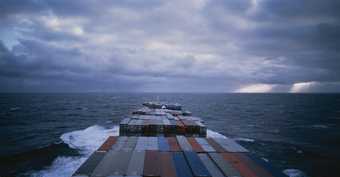
Fig.1
Allan Sekula
Panorama. Mid-Atlantic, November 1993, from Fish Story 1989–95
Courtesy Christopher Grimes Gallery, Santa Monica © Allan Sekula
As such, Fish Story transcends its role as the culmination of a trilogy, and in itself marks something of a shift in Sekula’s practice. The significance of the project was recognised soon after its appearance, yet it has been the focus of relatively little extended commentary since, despite being regularly described as a seminal work on the theme of globalisation.5 From today’s perspective, the ambition of Fish Story may be seen to lie not merely in its immense complexity and global scope but also in its emphatic challenge to the dominant climate of postmodern theory and practice of the late 1980s and early 1990s. Not least, Fish Story emerged into a European and North American art world whose urgent assimilation of the discourses of racial, sexual and gender emancipation had atrophied to the point of a stagnant liberal consensus, and a problematic decoupling of questions of cultural and economic alterity.
In his influential account of the ‘return of the real’ in North American and Western European art of the early 1990s, critic and art historian Hal Foster identified artists’ widespread turn towards the bodily inscriptions of identity at this time – as evidenced, for example, by much of the work included in the 1993 Whitney Biennial in New York – as complementary to a simultaneous ‘ethnographic turn’ towards the investigation of given social and cultural contexts beyond the art world.6 For Foster, each of these moves was legible as a reaction against the dominant climate of a postmodern culture indebted to the French philosopher Jean Baudrillard’s hyperbolic theories of ‘simulation’ as a media-saturated world of disembodied sign-play among ‘simulacra’ – copies without originals that implode the orders of reality and representation.7 As such, the renewed attention to the economic subject in Fish Story may be considered as a challenge not only to the shortcomings of an embodied identity politics. Sekula’s project also contested the concealment of the world of production by the art world’s attachment to the fatalistic orthodoxy of a ‘simulationist’ world of endless, autonomous image-proliferation.
In what follows, the case will be made for Fish Story’s pivotal place in a gradual shift, still nascent in the early 1990s, from a widespread culture of resignation and cynicism to one of renewed radical engagement in the art world. An important early aspect of this shift was the eventual coming of age of the concept of ‘postmodernism’ as more than merely a stylistic marker or synonym for the poststructuralist ‘critique of representation’, but rather as a periodising term, as the ‘cultural logic’ specific to a ‘postmodernity’ figured as the latest stage of a now fully global capitalism.8 Key moments in this final advent of the materialist account of the postmodern were the appearance of social theorist David Harvey’s book The Condition of Postmodernity in 1989, and the expansion of cultural critic Fredric Jameson’s foundational work on postmodern periodisation (dating back to the early 1980s) into a full-length book, Postmodernism, or, The Cultural Logic of Late Capitalism, published in 1991.9 Subsequent to this mature theoretical ‘capture’ of the postmodern, the term itself has proven largely unable to live down – and, consequently, to outlive – the history of its adolescent convulsions.10 And so, in the two decades or so since Harvey’s and Jameson’s landmark volumes, talk of ‘postmodernism’ has quietly receded from the centre of cultural-theoretical discourse. Art historian Jonathan Harris has identified the period between ‘about 1980 and 1995’ as the era ‘during which the terms “postmodern” and “postmodernism” achieved a relatively wide currency’, to be increasingly replaced by discussions of globalisation since that time.11 Jameson’s important essay of 1998, ‘Notes on Globalization as a Philosophical Issue’, evidences this switch, and its lengthy discussion of the cultural and economic aspects of globalisation is notable for its relative shortage of references to the postmodern as ‘ism’.12 Meanwhile, cultural theorist Ihab Hassan, in an essay first published in 2001, puts the matter more bluntly, and identifies the contemporary waning of ‘cultural postmodernism’ within an ongoing condition of ‘postmodernity’ as an ‘inclusive geopolitical process’.13 The present article seeks to position Fish Story as an important document within this larger context, as the complex interarticulation of Sekula’s effort to renew the terms of a realist art, in the wake of the hegemony of postmodern ‘simulacral’ culture of the 1980s, with the stirrings of a materialist critique of the new ‘globalised’ world of the 1990s.14
Emergence, exhibition, intervention
The successive chapters of Fish Story were shown individually in various locations as they were completed, but it was the exhibition of two chapters at the 1993 Whitney Biennial in New York that put the project under the international spotlight for the first time. Here, the global purview of Sekula’s work stood out against the predominance of identity-political practices elsewhere in the show; from Janine Antoni’s chocolate-and-lard sculptural trilogy Gnaw 1992 (Museum of Modern Art, New York), to the varied skin tones of an early instantiation of Byron Kim’s cumulative grid of monochrome paintings, Synechdoche 1991–2 (National Gallery of Art, Washington D.C.), and Sue Williams’s confrontational scrawled canvas, Are You Pro-Porn or Anti-Porn? 1992.15 As cultural critic Homi Bhabha tacitly acknowledged in his Whitney Biennial catalogue essay, and subsequently in his influential book The Location of Culture 1994, where Fish Story made reference to cultural hybridisation, this was clearly framed as a by-product of the enforced migrancy of labour attending global commodity exchange.16 By clearly articulating one process through which identity is socially and systemically formed (and re-formed), Sekula’s contribution was thus better able to withstand the reductive curatorial frame of the Whitney show as a whole, which was roundly criticised at the time for conferring a variously reductive, transparent and essentialist autobiographical reading on much of the work shown.17 Later in 1993, these difficulties were handled more successfully in the group exhibition Trade Routes, curated by Laura Trippi at New York’s New Museum of Contemporary Art, to which Sekula contributed Message in a Bottle, a chapter from Fish Story examining the decline of Spanish fishing, completed in 1992. Trade Routes was notable for its explicit thematisation of globalisation through a focused examination of the effects of computer technology on financial markets and international trade, while imbrications of the cultural and economic were clearly broached in a number of works by the show’s eighteen artists.18
In its complete exhibition form, first shown in 1995–6 in the port cities Rotterdam, Stockholm, Glasgow and Calais, Fish Story consisted of 105 colour photographs organised as seven chapters, or sequences, that were interspersed with twenty-six text panels across a number of rooms.19 To these were added two slide projections that were omitted from the accompanying book, published in 1995, each consisting of around eighty transparencies, shown at fifteen-second intervals in a separate projection room. The whole ensemble was later exhibited at the Henry Art Gallery, Seattle, in 1999, and then at Documenta 11 in 2002, curated by Okwui Enwezor, where it appeared considerably less isolated than at the Whitney Biennial nine years earlier, taking its place among a large number of photographic and documentary film works.20 The overarching subject of Sekula’s material was global maritime industry, and especially its role as the largely unseen bedrock of the worldwide distribution of commodities. Fish Story thus confronted the space-time compression of a consumerist world whose latest buzzword, ‘friction-free capitalism’, conjured images of a dematerialised economy newly enabled by the computer as ‘the sole engine of our progress’, with its own abundant imagery of the slow, weighty transportation of goods across the oceans, a vast water-borne iron and steel infrastructure, and of lives defined, both at work and at leisure, by its shifting global parameters; an affront to the ‘blinkered narcissism of the information specialist’, as Sekula himself has remarked.21
The most significant economic shift in the recent past for Fish Story had been the collapse of the Eastern Bloc at the start of the 1990s, and Sekula has suggested this as the overriding impetus for his six-year project, whose scope is matched only by the newfound reach of capitalist market forces around the globe from this time forward, for which the expansiveness of the oceans serves as a fitting metaphor, and their navigation an equally apt metonym.22 However, the collapse of the Soviet Union is not the only back-story to Fish Story. In fact, the implosion of the Second World arguably takes second place in Sekula’s project to the explosion of an export market further east, whose origins are in any case traceable somewhat further back, as the political economist Robert Brenner has demonstrated, to the crisis of profitability in United States industry between 1965–73, signalled by the increased competitiveness of German and Japanese production from around that time.23 Among other factors, this ushered in a twenty-year period of stagnation in the US economy, which was only mitigated by ‘more or less continuous … devaluation of the dollar with respect to the yen and mark’ from 1985 onwards, one effect of which was to hasten ‘an unprecedented explosion of export-based manufacturing expansion throughout East Asia, where economies for the most part tied their currencies to the dollar’.24 Perhaps above all else, Fish Story confirms this picture of an intimate link between the deindustrialisation of the economies of the North and the industrialisation of the South and East.
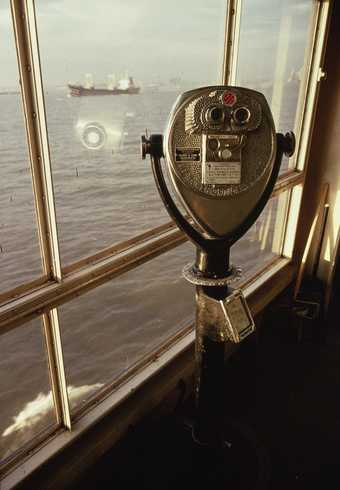
Fig.2
Allan Sekula
Boy Looking at His Mother. Staten Island Ferry. New York Harbor. February 1990, from Fish Story 1989–95
Courtesy Christopher Grimes Gallery, Santa Monica © Allan Sekula
The counterpart, then, to the familiar post-industrial and postmodern visions of social reproduction founded on service labour, the creative industries and the fashioning of consumer experiences in the advanced societies of the North has been the ebbing visibility of material production over the last thirty to forty years in those same countries. While commodity chains have proliferated exponentially, their links have become both more numerous and more fragile as a result of such trends as the dissociation of brand ownership from factory ownership, and the relocation of factory work to ad hoc, clandestine Export Processing Zones in the global South as well as subterranean sweatshops in the North. One significant consequence of this has been the expansion of an ever larger industrial labour pool for capital’s ever more itinerant hand to grasp, and the rapid growth of a global reserve army of labour; an underpaid ‘precariat’ whose insecurity is the flipside to the cherished autonomy of the cosmopolitan freelancer.25 Art historian Benjamin Buchloh, in an extensive essay that appends the Fish Story publication, has observed the historical collusion of visual culture in this scheme, remarking that:
in a self-declared post-industrial and post-working class society, where large segments of labor and production are in fact concealed from common view since they are exported to the geo-political ‘margins[’] … the experience of production and the conditions of industrial labor have been banned by a massive representational prohibition from modernist visual culture.26
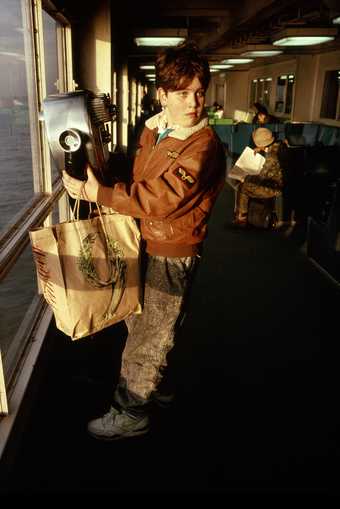
Fig.3
Allan Sekula
Boy Looking at His Mother. Staten Island Ferry. New York Harbor. February 1990, from Fish Story 1989–95
Courtesy Christopher Grimes Gallery, Santa Monica © Allan Sekula
Buchloh here suggests not merely that the representation of industrial labour within Western visual culture has gradually disappeared as the natural effect of its object retreating ever further from view, but that the active prohibition of that representation stems from visual culture’s own investment in the various fantasies of a post-industrial and post-working-class world. This is true enough of advertising and the mass media. However, large sections of the art world of the 1980s, basking in the glow of commodity aesthetics, had done little to effectively counter these myths (that is, where a similar investment had not, at least tacitly, been made). Fish Story’s articulation of the global, macroeconomic scene is not merely that, but also a powerful intervention into precisely this insular artistic and art-institutional picture. If art is indeed situated at the nerve centre of this cultural amnesia as the standard bearer for ideologies of the ‘weightless economy’, Fish Story asks whether the visual arts might in fact be the ideal arena in which to confront this repression, by way of a photographic activism that would disarm art’s First-World ideologies of simulacral self-sufficiency.27
Vicissitudes of labour
Accordingly, Fish Story targets numerous aspects and local effects of the world-historical picture, concentrating on the painful transitions of Europe and the US from industrial to post-industrial societies, and the contemporaneous industrialisation of East Asia.28 The two slide projections, Dismal Science 1989–92 and Walking on Water 1990–5, trace the decline of four shipyards in the First and former Second worlds – Glasgow and Tyneside in the first series, and Warsaw and Gdansk in the second – while the very first images of the first chapter of photographs (the first two photographs of the book), also entitled Fish Story 1990–3, portray an aspect of America’s tourism-oriented service society aboard the Staten Island Ferry, as a young boy handles the coin-operated binoculars on the lower deck (fig.2 and fig.3). The first chapter goes on to focus largely on both the busy and abandoned harbour areas of California, including an empty shipyard after its use as a location for a Hollywood film shoot (fig.4). Paired with this photograph in the book and exhibition, a telling image from the sequence shows a rusty spanner in a derelict welder’s booth in the Los Angeles port district of San Pedro, disturbed by Sekula from its long rest on an equally rusty ledge to reveal its silvery image in the only rustless area of the surface (fig.5).29 The neglected spanner appears to stand not simply for the marginalisation of manual labour at today’s automated container ports, but by extension, and in proximity to the allusion to Hollywood’s fictions, for the disappearance of labour and production from the broader social imaginary.
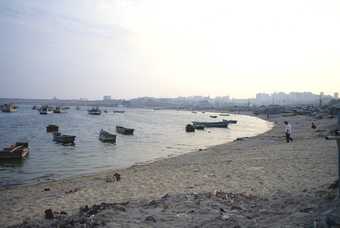
Fig.4
Allan Sekula
Doomed Fishing Village of Ilsan, September 1993, from Fish Story 1989–95
Courtesy Christopher Grimes Gallery, Santa Monica © Allan Sekula
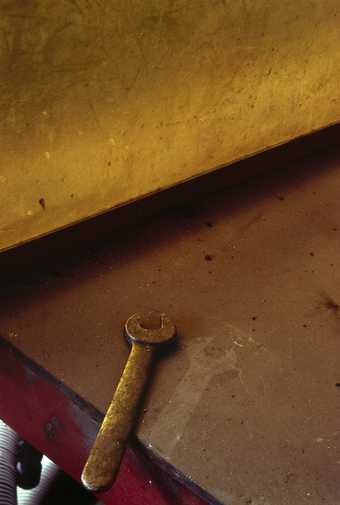
Fig.5
Allan Sekula
Welder’s Booth in Bankrupt Todd Shipyard. Two Years After Closing. Los Angeles Harbor. San Pedro, California. July 1991, from Fish Story 1989–95
Courtesy Christopher Grimes Gallery, Santa Monica © Allan Sekula
The fourth chapter, Seventy in Seven (completed in 1994), takes the burgeoning shipping industry of South Korea as its subject, together with its winners and losers: a golf course, set against the backdrop of Ulsan’s numerous cranes, reserved for Hyundai Heavy Industries shipyard workers; beachfront inactivity in the ‘[d]oomed fishing village of Ilsan’; and a monument to Hyundai workers killed during the construction of a highway between Seoul and the major port city Pusan.30 As the golf course photograph intimates, a clear theme of the disappearance of public space amid rampant private development runs throughout this chapter, while the imprint of Hyundai on the pleasures and necessities of daily life is near-ubiquitous, as befits the sinuous, vertically integrated reach of the South Korean chaebol.31 There are Hyundai apartments and automobiles, but also, midway along the sequence, a photograph announcing the imminent construction of a theme park in Ilsan, followed by an image of an ex-fisherman-turned-reluctant-factory worker, and a panoramic diptych of the village’s beach, the right-hand image of which illustrates the creeping encroachment of industrial and commercial development in the distance (fig.6). The conveniences of a raised standard of living and the twin impositions of Fordist work and leisure are here inseparable.32
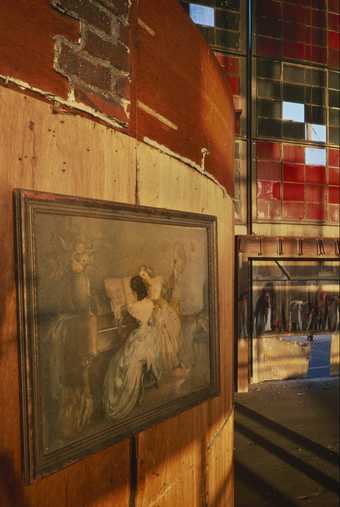
Fig.6
Allan Sekula
Remnants of a Movie Set. Abandoned Shipyard. Los Angeles Harbor. Terminal Island, California. January 1993, from Fish Story 1989–95
Courtesy Christopher Grimes Gallery, Santa Monica © Allan Sekula
The first and fourth chapters demonstrate most clearly that geography is an organising principle of the seven photographic sequences, and it is on the basis of this identification in particular that the viewer is encouraged to draw such parallels as that between Northern industrial decline and Southern industrial development, and thence to draw further local parallels within and across the chapters. From there, it is an inviting but treacherous step to seek in individual images a summary key to the project’s meaning. Not merely because of its placement, the very first image of Fish Story as a whole, in fact, provokes just such an attempt (fig.2). It shows the Staten Island Ferry binoculars, minus the boy, directed through the window of the deck towards another ship in the hazy middle distance, the metallic sheen of the casing reflected in the same window back towards the viewer. Everything in this image, from the dirt-flecked window panes to the cleaners’ equipment that is barely concealed in the corner space at the window’s edge, conspires to suggest the tired tenor of a culture that has not only failed to live up to the post-industrial promise, but that also greets its industrial heritage with dewy-eyed nostalgia and its service-industrial present with malaise.33 The binoculars’ touristic associations also spark a relation with an image, later in the sequence, of the architect Frank Gehry’s 1988 model for a Lead Fish conference room on display at the Los Angeles Museum of Contemporary Art (fig.7), which is legible now only as a premonition of the Guggenheim Bilbao, that other tribute to the supposed obsolescence of maritime industry via its local displacement by tourism. Sekula was later to visit Gehry’s building itself for a diptych entitled Bilbao that became the second and third images of a subsequent photographic project, TITANIC’s wake 1998–2000.34 Here, positioned on a hillside, Sekula’s camera peers down on the museum for the first shot, the Basque city spreading out behind. Nudging the view a little to the right, the second image reveals a pocket of urban dereliction just across the river, shielded from the museum by a row of apartments. The diptych suggests that Gehry’s museum is a mere front; a ‘monument to the absolute hegemony of intellectual labor afforded by computer-based manufacturing’, as Sekula’s accompanying text to TITANIC’s wake declares.35 For Sekula, then, visual culture’s prohibition of the representation of labour – or, more generally, its disavowal of the social fact of production – extends beyond image-making to the built environment itself. He shares this view with another of the museum’s critics, artist Andrea Fraser, who elsewhere discusses the Guggenheim audio guide’s references to the cutting and shaping of the building’s panels ‘by robots working to a computer program developed for aircraft design’, and concludes that the museum as a whole expresses itself as the ‘product of a world in which the human labor of production does not exist’.36
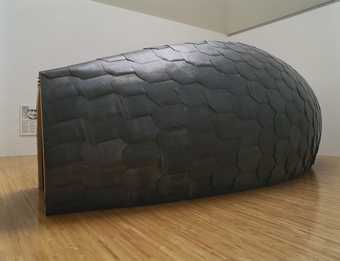
Fig.7
Allan Sekula
“Lead Fish”. Variant of a Conference Room Designed for the Chiat/Day Advertising Agency. Architect: Frank Gehry. Installation at the Museum of Contemporary Art, Los Angeles. May 1988, from Fish Story 1989–95
Courtesy Christopher Grimes Gallery, Santa Monica © Allan Sekula
However, if the reflex of contemporary consumer society in the global North is to foster a romanticised vision of industrial labour consigned to an imaginary past, this may be as refuge from the urgent pressures of the present. Tourism itself (and, by extension, the rise of the service industries in general) cannot accommodate, nor can the touristic view disguise, the impoverishment of post-industrial decline, of which evidence abounds in Fish Story, from the scavengers of Los Angeles harbour to the long queues of a Gdansk unemployment office. With remarkable resonance for today’s world of global economic crisis, Fish Story makes plain that it is the supposed fixes of neoliberal austerity that nowadays force workers into ever more precarious circumstances. As is further elaborated in the series of extended encounters with dispossessed Angelenos in Sekula’s 2010 (filmic) return to the oceans, The Forgotten Space, unemployment can quickly become a matter of hand-to-mouth survival, even the use of shipping containers for habitation, whether in Los Angeles – the ‘first world capital of homelessness’ – or on the beach at Veracruz, Mexico.37 Sekula’s caption for an image of striking workers in Galicia, Spain, taken in 1992 (one of only two images of protest in Fish Story), further suggests the sheer depth of neoliberal orthodoxy by the 1990s. Attesting to the weakening of ties between trade unions and the parliamentary left that is the obverse face of the tightened grip of global corporate power suggested by the Hyundai example, Sekula notes that the workers’ opposition is to ‘the Socialist government’s cutbacks in unemployment benefits’.38
Realism’s incomplete project
The binoculars in Fish Story’s first image, as well as the reflection that interrupts the line between the device and the distant ship – as if to remind the viewer of the window pane and, by analogy, the photographic image plane as mediating frame – may be thought to prefigure the reflexivity of the project as a whole. Specifically, these features might hint at Fish Story’s underlying recognition that while unmediated vision is, by definition, an impossibility in photography, and while visibility and visual access are doubly at issue where the subject is as vast, unmappable and volatile as global capital, neither is the recovery of social knowledge through photography a task to be abandoned.
Since the 1970s Sekula has been one of the most influential critics of the ‘naïve conventionalism’ of documentary photography; his voice one among many, influenced by the poststructuralist and postmodernist theory that was still ascendant in the 1980s, to have undermined the naturalist assumption that photography might offer ‘truths’ miraculously free of ideological inscription, or that ‘intrinsic’ photographic meaning is determinable outside of photography’s manifold contexts of presentation and the diverse uses to which it may be put.39 For Sekula, as for others, this had begun as a critical interrogation of positivist claims for the total objectivity of photography, these premised on the indexicality of the photographic trace – the direct imprint of empirical reality on the photograph as the physical effect of light on film. But by the 1990s this postmodern critique had hardened into the opposite doxa, namely that social knowledge was irrecoverable by photography, and that realism was a defunct project.40 What Buchloh, in his Fish Story essay, calls the ‘opacity of the sign’, or what Jameson discussed in 1984 as the disappearance of the referent amid a play of pure signifiers – with no access to a truth or ‘transcendental signified’ beyond this interminable exchange – had become a postmodernist shibboleth.41 ‘Critical realism’, in the sense given the term by the Marxist theoretician Georg Lukács in the 1930s, had earlier meant the rescue of realism from both its Stalinist distortion and from a dogmatic ‘anti-realist’ modernism, ‘bereft of content … [and] cut off from the mainstream of society’.42 For Sekula, in the early 1990s, it meant realism’s recovery from postmodern ‘hyperreality’, the supposed condition of a pervasive loss of the real wrought by the dominant logic of the simulacrum. For Sekula, a ‘critical representational art … that points openly to the social world and to possibilities of social transformation’ remains the only art worthy of an oppositional politics, as well as a necessary counter to a situation in which ‘the old myth that photographs tell the truth has been replaced by the new myth that they lie’.43 In other words, to understand the notion of the play of signifiers as licensing some absolute elasticity of signification is no less false than a belief in photography’s total and transparent objectivity. The task is, rather, to insist on the historical, social and institutional inscription of photographic meaning, of the place of photographs within different discourses and image regimes; in short, to understand meaning as delimited within changeable and overlapping contexts.
Rather than anything as pre-given and static as a genre, then, realism for Sekula is above all an emancipatory project that, to conjure Lukács, must ‘portray … man in the whole range of his relations to the world’, while capturing ‘tendencies of development that only exist incipiently’ in order to signal and thereby promote prospects for radical social change, however dim.44 The key to Sekula’s activist endeavour is not merely to bring home to his audience some of the myriad local effects of global capitalism, but to relate his necessarily incomplete impressions of the totality dialectically. Above all, this means to recognise the inherent contradictions of a complex and continuously changing world-system, and indeed to insist on contradiction as the very locus of change. The foregrounding of the persistence of social contradictions (and, in particular, economic disparities) under global capitalism is at work, accordingly, not only within each chapter and each location of Fish Story – for instance, in the simultaneity of rising affluence and the dejection of formerly autonomous workers in South Korea’s port cities – but also in the geo-economic contrasts between conditions of rise and decline in different corners of a post-Soviet, globally interconnected world.45
Beyond this, a critical realism must, above all, be self-critical, and alert to the inevitable limitations of its attempt to apprehend the enigma of capital as a relation that exists only in and as movement.46 And so, Sekula works throughout to resist the possibility of any easy interpretative resolution or reductive summation of Fish Story. Within each titled chapter of photographs, the images display a wide range of types, so that no single pictorial mode predominates. There are microscopic close-ups as well as panoramas and, between the two, there are highly detailed and carefully composed views of a variety of oceanic, coastal, factory and shipyard scenes. On land the viewer is privy to these mostly unseen frontier towns for the global circulation of containers, within which individual people occupy a variety of positions. Often absent, obscured or incidental, sometimes central, mostly at work on specific tasks, and occasionally dwarfed by some hulking industrial apparatus, the subjects include welders, dockers, market traders, scavengers, rescue workers and fishermen, as well as the unemployed, children and families. Sekula here offers a model of photographic visibility that, by recognising its own inescapable inadequacy, thereby strives to be adequate to the magnitude and complexity of the subject at hand. The gulf between the universal movements and local effects of capital is also that between the invisible and the visible, the abstract and the real, and this is attested to in the pauses and gaps between Sekula’s focus on the fate of individuals and localities as the lived elements of a broader historical trajectory, and his pulling back to draw closer to a systemic perspective. Sekula’s calculated frustration of the comprehensive overview may also help to explain the patchwork quality of his two-part essay, Dismal Science, published in the Fish Story book, in its treatment of numerous artistic and literary depictions of waterways and seafaring, from Dutch marine painting to Popeye, and from Moby Dick to Robert Smithson’s 1967 essay, ‘A Tour of the Monuments of Passaic, New Jersey’. Throughout, the textual material performs a circumferential function in relation to the photographs, as do the photographs in relation to the texts; each is the complement, but not the interpreter, of the other.
Thus Fish Story, as a textual and photographic assemblage, astutely avoids any suggestion that Sekula’s view is itself panoramic, and the sequential organisation of the photographs is among the means by which this is ensured. Sequences, Sekula maintains, are to be differentiated from series by their coherence as uniquely determinate arrangements (generally with a beginning and an end), thereby offering more potential resistance than the ‘metronomic regularity’ and indifference of the series – the seriality of much documentary photography or the exchangeability of the photographic typology – to the illegitimate isolation of single images, ripe for either ideal (aesthetic) or real (commercial) appropriation.47 As Buchloh observes, the technical quality of Sekula’s images themselves lies somewhere between the deskilled ‘snapshot’ and the ‘professional artisanal photograph’.48 In this way, it refuses the overt artisanry and latent or manifest pictorialism of documentarians from the Americans Lewis Hine to W. Eugene Smith, and onwards to the Brazilian Sebastião Salgado (to extend the lineage once identified by Sekula as a ‘continuous tradition of expressionism in the realm of “fact”’), whose work has proven disposed to such a fate.49
To be sure, the unity of Sekula’s sequences is notably loose, and identifiable passages within each of Fish Story’s chapters seldom follow the progressive logic of a given activity or process, such as can be found in some Soviet photographic sequences of the 1920s; for example, Alexander Rodchenko’s project charting the production and distribution of newspapers from 1928.50 Where a progression is apparent, Sekula tends to show successive moments within the course of a single event (such as the loading of giant cauldrons aboard a cargo ship in Los Angeles harbour), rather than one event following another, and never across more than two photographs. Nevertheless, Sekula’s images are clearly grouped and organised in relation to the relevant accompanying texts both in the book and on the gallery wall, as images of the Documenta 11 installation confirm. While the texts bookend the photographs in the publication, partition walls demarcating the different chapters in the gallery allow for a degree of variation in the spatial arrangement of texts among images without relinquishing that clarity. In the Binding Brauerei at Documenta, a display of Candida Höfer’s large colour photographs of the twelve existing casts of Rodin’s The Burghers of Calais, equally (and generously) spaced at uniform height in an adjacent room to Fish Story, set the more varied spatial dynamics of Sekula’s display in relief.51 In fact, the spatial variation of Fish Story was at odds with many of the photographic exhibits in Kassel that year, from David Goldblatt’s images of apartheid Boksburg at the turn of the 1980s, to Michael Ashkin’s grid of 133 gelatin silver prints depicting the blighted landscapes of the New Jersey Meadowlands, whose fierce geometrical arrangement clearly echoed that of Bernd and Hilla Becher’s post-industrial typologies, themselves on show in the KulturBahnhof.
The reflexive form of the photographic sequence, deployed by Sekula, thus eludes any crude opposition between ‘objective’ realism and modernism as a constructed, subjective or expressionistic aesthetics. Rather, Sekula’s construction of what Buchloh calls Fish Story’s ‘realist montage-aesthetic’ reclaims those aspects of Soviet photomontage and photo-essay practices of the 1920s that were, in different ways, both modernist and realist.52 That is to say that the spatial juxtapositions and breaks of both photomontage and photo-essay works were supported as a credible revolutionary aesthetics both for their ‘modernist’ expansion of the content of perception, and for the ‘realist’ possibility of their opening up the realities of proletarian experience to a simultaneity of diverse perspectives.53
In Sekula’s hands, then, montage is by no means a disruptive, inherently anti-narrative form (the montage of caricature), but is rather ‘a principle by which a loose concatenation of images limits the polysemic character of any given component image’.54 And lest the very narrative coherence or concision of the photographic sequence itself still remains open to the charge of a latent and spurious mastery on the part of the artist, the presentational format of the slide sequences are on hand, in the exhibition version of Fish Story at least, to disrupt or suspend, if not the substance of these qualities of closure (as determined, to be sure, by the content of the image sets themselves), then at least the viewer’s clear and immediate apprehension of them as such. Not only does the slideshow test the limits of the spectator’s visual memory by precluding the simultaneous viewing of more than one image but, by repeating content on a continuous loop, the slide sequences will, at least initially, confound the attempt to locate a beginning and an end.55 The final slide of Dismal Science is a teaser in this respect: a rear view of Karl Marx’s grave in Highgate Cemetery, London, its grey granite base occupying around two thirds of the image, gives the impression of a punctuation mark for the series (fig.8). It is perhaps a full stop, but more likely – inserted into the continuous loop – a colon, a hyphen, or even an ellipsis, standing in for Fish Story’s necessary exclusions.
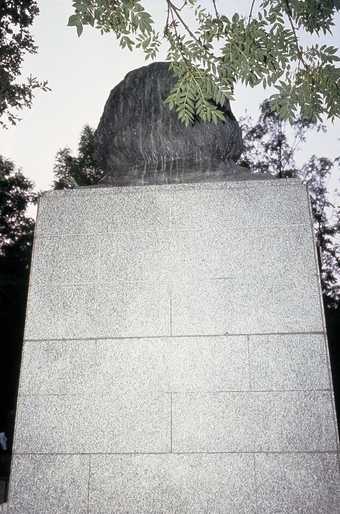
Fig.8
Allan Sekula
Grave of Karl Marx and His Family. Highgate Cemetery, London, July 1989, from Dismal Science 1989–92
Courtesy Christopher Grimes Gallery, Santa Monica © Allan Sekula
Picturing capital
Each of Sekula’s seven chapters pose the question of the relative gains and losses for global insight of their orientation around a particular locality (the predominance of California in Fish Story or the centrality of the Polish context in the second chapter, Loaves and Fishes, for instance), while the sequences also admit the place of the contingent encounter within the relatively loosely imposed parameters of narrative and theme. (Buchloh identifies a precedent for this ‘dialectic of contingency and contextuality’ in the Soviet model of the ‘accumulation of snapshots’ in photo-files: neither ‘follow[ing] the rigid structure of an archival order … [nor] governed by a mere principle of randomness’.)56 Consistent with all of this is the rhythmic variation, recurrent throughout Fish Story, between temporally and spatially intensive and extensive modes. The variable pace of Sekula’s attention is felt in the contrast between the relative geographical coherence and often limited time span of the individual photographic sequences themselves (intensive), and the geographical, temporal and thematic gaps between them (extensive) as they traverse the oceans from California to Rotterdam, Portugal to Mexico (fig.9).57
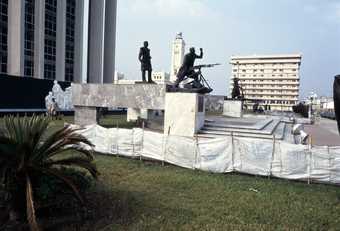
Fig.9
Allan Sekula
Monument to the Defenders of Veracruz Against the U.S. Marines in 1914. Pemex Headquarters, Malecón, March 1994, from Fish Story 1989–95
Courtesy Christopher Grimes Gallery, Santa Monica © Allan Sekula
As much as anything else, these alternating rhythmic currents foreground the idiosyncrasies of Sekula’s own working itinerary, perhaps also its partial determination by individual circumstance and personal interest – aspects that would later be foregrounded in Fish Story’s film sequels, The Lottery of the Sea 2005 and The Forgotten Space, by the use of hand-held camerawork in the former, and by author-narration in each. Sekula admits as much in his postscript to the 1995 book (‘Sites were chosen for reasons that were whimsical as well as thematic’) and even hints at a subjective basis for his project when he states that ‘the historical present constructed by Fish Story is roughly coincident with my own working life as an artist and writer’.58 On occasion, Sekula emphasises the chance intervention of his subjects in the determination of what is finally seen, a clear example being the aforementioned South Korean ex-fishermen’s gesturing in despair towards the beach at Ilsan behind him, an image that is immediately followed by Sekula’s panoramic diptych of the beach itself.
What, then, could be the significance of the revelation of contingency and subjectivity (including Sekula’s own) in Fish Story? Most importantly, it would seem that, in any attempt to portray global capitalism, a danger of detachment and reification will be heightened by the sheer invisibility of the systemic. Capitalism is both a world system and a process without agency. There is all the more risk, then, for the photographer who makes this their theme, that particular circumstances will come off as the passive illustration of immutable historical forces, and that his or her individual subjects will read as helpless victims. Sekula’s deflation of conceptual mastery or the ‘total picture’, by way of the revelation and accentuation of contingency, idiosyncrasy and subjectivity in both Fish Story’s conception and execution, might then become a means to alleviate this problem, not least by way of his conceptual and presentational work of editing in order to foreground the project’s spatial and temporal gaps, and intensions and extensions.
Deflation of mastery and revelation of contingency are, then, also the work of post-production; not only the careful contextualisation of text in relation to image but also aspects of promotion and exhibition that precede and surround the project’s content. Buchloh discusses a poster designed by Sekula for the 1994 exhibition Fish Story (Work in Progress), at the Berkeley Art Museum, on which two images from the project appear together, as indeed they are positioned side by side in the gallery exhibition and the publication, while they also appear on the front and back of the softcover edition of the book. One is an extreme close-up of a ship’s inclinometer (fig.10) and the other a mid-Atlantic panorama aboard the same ship, looking forward from the back of the top deck, a large number of containers spreading out ahead (fig.1). While, for Buchloh, the close-up is an example of Sekula’s use of the ‘seemingly irrelevant and banal’ photographic detail as a ‘Brechtian intervention that reminds the viewers … of the constructed nature of the representation’, the pairing of close-up and panorama as two distinct pictorial modes further presages Fish Story’s partial status as ‘a rhetoric of photographic discourses and conventions’.59 In particular, the question of that which escapes the frame of both photographs, of what the close-range and the long-view together leave out, suggests what Sekula elsewhere admits must inevitably be the partial failure of his (or indeed any) attempt to picture capital at work as it crosses the earth to reproduce itself. In neither image, then, is the ship itself revealed – the inclinometer alone reveals the presence of what the panorama refuses to yield, the sheer volume of containers in that image obscuring any glimpse of the deck.
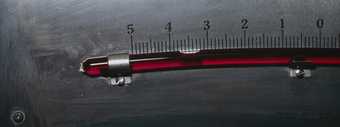
Fig.10
Allan Sekula
Detail. Inclinometer. Mid-Atlantic, November 1993, from Fish Story 1989–95
Courtesy Christopher Grimes Gallery, Santa Monica © Allan Sekula
In sum, the admittance of contingency and subjectivity are integral to the critical realism of Fish Story. It is on these bases that Sekula’s refusal of the ‘ideology of the simulacrum’ does not simply rebound into that other ‘dominant model’ of conceptual photography (for which Buchloh’s paradigmatic example is the ‘melancholic archaeology of industry’ of the Bechers), namely the hubristic revival of objectivity, and ‘the resuscitation of photography as the chosen discipline for rendering the “real”’.60
Sekula’s photographic activism
The placement of the image of containers at sea on the Berkeley exhibition poster makes plain that commodity distribution and global trade are the underlying bonds connecting the entirety of Sekula’s project. The design for the poster as a framing device in this manner – as a minimal delimitation of the project’s significance and scope – suggests Sekula’s own awareness that the constitution of a decisively partisan or activist practice is equally dependent on its communicative force as on the adequacy of its testimony to the subject’s complexity, as recorded in the visual and textual content. The form of the poster as a supplemental feature of Fish Story that serves to anchor its thematic concerns is, then, a way for Sekula to ensure what Buchloh calls ‘the potential of communicative action between readers/spectators … and the artistic proposition’, without thereby compromising that complexity.61
Spurning both fact and fiction, and poised between opacity and visibility, complexity and legibility, fragment and totality, Fish Story thus unfolds according to a persistent ‘neither/nor’ logic. In its condition as (something approaching) the negative sum of its deconstructed parts, it mounts a sophisticated critique of the photographic conventions that Sekula’s critical prose elsewhere deflates. But as it carves its position within and between these conventions, forging a space of resistance in the aesthetic field as a complex configuration of form and content, Fish Story simultaneously occupies a real position within the overlapping institutional fields of documentary photography and contemporary art. As is suggested, not least by his sensitive involvement with the project’s framing, Sekula is more aware of this than anyone. Nonetheless, it must be remembered that these positions are interdependent and mutable and, in particular, that the work’s critical import may be vulnerable to historical shifts in the reception of the former institutional field within the sphere of the latter.
For Buchloh, documentary as a form of realism is of utmost importance in this equation. He argues that Sekula’s photographic and textual investigations have, since the 1970s, been ‘culturally illegible’ within the dominant terms of post-conceptual, postmodern photographic practice.62 Sekula’s work, Buchloh insists, has been amenable neither to the ‘disinterested specularity … of an exclusive deflection onto the signifier’, nor to the depiction of the social as a ‘world of random discontinuities and anomic conditions’.63 What these two models share, and what Sekula’s critical realism contravenes, is an investment in ‘an exclusive and dominant aesthetic of the fragment’ (whether that of sign or social fact), whose art world hegemony is a fallout of the supposed death of realism, nowadays widely perceived as an ‘ontological condition’.64 Postmodernism and realism are, it seems, irreconcilable. Once again, Jameson has been the prophet here, and Buchloh cites his pessimistic 1971 proclamation that ‘the individual and the social have fallen apart so effectively that they stand as two incommensurable realities’ with no common language.65
Buchloh argues that Sekula’s apparent illegibility within the art world – premised also on the threat posed by documentary practices towards the ‘high-art status of … newly accredited photographic objects’ – has fostered what he thereby deduces to be his clear ‘distance from the field of contemporary artistic production in general’.66 Doubtless he is correct in this assessment up to a point, despite his neglect to mention the inclusion of Fish Story, in unfinished form, in the prominent fixture on the contemporary art calendar that is the Whitney Biennial. But Buchloh’s argument also testifies to its formulation on the historical cusp of the widespread revival and visibility of documentary and realist practices in the institutional art world: examples from Documenta 11 would include the presentation of Amar Kanwar’s film study of the India-Pakistan border, A Season Outside 1997, following well-received showings at film festivals in Mumbai and San Francisco; Eyal Sivan’s documentary film of the Rwandan genocide, Itsembatsemba, Rwanda One Genocide Later 1996; Ashkin’s New Jersey prints; and colour photographs by Lisl Ponger of activist graffiti from the anti-capitalist uprising in Genoa in July 2001. Fish Story itself stands as a signal early instance of a growing institutional visibility of oppositional practices such as Sekula’s that began to gather pace towards the end of the 1990s. The inclusion of Buchloh’s efficient essay in the Fish Story publication was surely of use in this regard, and Buchloh’s own portrayal of documentary as a form of realism is, if anything, indicative of its subsumption by the artistic field, as it already presumes its commensurability with realism as aesthetic code, as artistic ‘genre’. In short, the boundaries of that institutional field are clearly more porous than Buchloh is here willing to admit, and with his help, Fish Story becomes legible within the artistic field precisely as a contravention of the dominant terms of post-Conceptual photographic practice. Indeed, with the inclusion of Buchloh’s essay-supplement in the publication, that legibility-as-contravention becomes almost a self-fulfilling prophecy. Seen in this light, Buchloh’s insistence on Sekula’s lingering renegade status appears, not disingenuous, but certainly ripe for revision within, and thanks to, the context of his own critical appraisal.
But if the institutions of the art world have, in the last two decades, proven more than amenable to critical documentary practices, and happy to shape them to their discourse with little friction, what strength of challenge to the dominant ideologies of that world do they in fact present? Indeed, to what extent may Sekula’s expansive portrait of global maritime industry have itself been tacitly content to occupy the structural position of radical token within the broader institutional field of contemporary art of the mid-1990s? Might Sekula’s ‘ethics of visibility’ even, to a degree, be resigned to its own marginal visibility within that field? 67 Sekula’s model of a critical realism allows for itself – leaves open – the possibility of its partisan allegiance to an oppositional politics becoming part of a broader praxis; however, this facet will inevitably lie dormant in the absence of the emergence of a coherent radical force itself. The formal and thematic openness of Sekula’s critical realism is also its openness to circumstance, and this very potentiality is its key strength. It allows for each of what Jameson has argued to be two necessary but irreconcilable strategies of a political art that would seek to give voice to the disenfranchised and voiceless, namely ‘affirmation of the cultural group’s strength’ and insistence ‘on that group’s miseries’. 68 Each of these strategies, Jameson attests, may ‘correspond to different historical moments in the struggle, and evolving local opportunities and representational needs’.69 Fish Story’s subject, then, is change and possibility in the wake of Soviet collapse, East Asian industrial expansion, the relaxation of borders to trade, and the global consolidation of corporate power; its world is not yet that of the tempered optimism found in Sekula’s later slide sequence Waiting for Tear Gas (White Globe to Black), an overtly partisan photographic document of the N30 demonstrations in Seattle in 1999.70 In the contrast between the two series, and perhaps in the contrast between the structural complexity of the earlier project and the structural simplicity of the 1999 series, what can be observed are both the constraints and the opportunities of a photographic ‘ethics of visibility’, since what is largely visible in Fish Story, besides anger and intransigence, is defeat and disorientation as a result of capital’s global upheavals. Fish Story was completed and first exhibited in January 1995, before the wave of general strikes in France that occurred between November and December that year. It was, moreover, wrapped up nearly two years before the general strike by South Korean automotive and shipbuilding industry workers that took place between December 1996 and January 1997, and its shortage of protest imagery is striking today, especially when set against the high incidence of protest at various harbour sites in Sekula’s later film, The Lottery of the Sea.
The dialectical complexities and contradictions of Fish Story are finally, then, of a piece with the project’s conflicted historical moment, in the wake of the historical failure of Marxism-Leninism and at the dawn of a new activism that would lead onward to the Movement of Movements in Seattle and beyond. The world’s oceans, the labour aboard its ships and in its harbours, have featured heavily in Sekula’s activities since Fish Story, constituting a body of work that offers a sustained corrective to the clichés of hybrid consumer culture so often paraded in artistic ‘examinations’ of globalisation. Meanwhile, the oceans’ pivotal place in the reproduction of contemporary society, and therefore its key political importance, has begun to figure increasingly in work by younger artists. Fish Story’s influence is palpable in Zineb Sedira’s Floating Coffins 2009 (Tate T13331), a fourteen-channel video installation of the harbour city of Nouadhibou and the flotsam and jetsam along the nearby Mauritanian coastline, as well as Chen Chieh-jen’s film The Route 2006, which depicts an imaginary protest at the Port of Kaohsiung in Taiwan, where, in 1995, Neptune Jade unloaded its cargo, having been refused anchorage elsewhere in solidarity with Liverpool’s striking dockers. A decade or so before these works, Fish Story itself resonates with the gradual unravelling, identified by the labour sociologist Beverly Silver, of a broad social-scientific consensus that labour movements of the 1990s were in a severe or even terminal crisis.71 Whereas the political scientist Francis Fukuyama had famously declared, in 1989, that the global triumph of liberal-capitalist democracy heralded the death of competing ideologies as the ‘end of history’, Fish Story accords with the tempering, if not the eclipse, of Fukuyama’s moment in the sun by the magisterial weight of Pierre Bourdieu’s immense La Misère du Monde in 1993.72 Marx’s memorial bust in Highgate may have its back to the camera in the final image of Dismal Science, but the familiar shape of the head is nonetheless clearly discernible, and asks to be continually reread, whether as full stop, ellipsis or comma. The stone cuts a ghostly figure against the dusk, and as the philosopher Jacques Derrida wrote in Spectres of Marx in 1994, when Fish Story was nearing completion, ‘a ghost never dies’.73 Like Sekula’s ocean, and its return in successive projects, ‘it remains always to come and to come-back’.74

